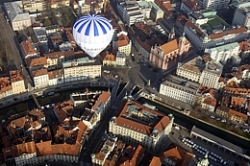Ljubljana (Republic of Slovenia)
| Twinned since | 1966 |  |
| Population: | 278,000 (2007) | |
| Area: | 106 sq. miles | |
| Website: | www.ljubljana.si |
Ljubljana lies between the Julian Alps and the Adriatic and with only 278,000 inhabitants it is one of the smallest capital cities in Europe.
The university city is the cultural, economic and political centre of Slovenia. In Ljubljana there are numerous theatres, museums and one of the oldest philharmonic orchestras in the world. The city is famous for its architectural monuments, among them the Castle, the Town Hall, the Franciscan Church, the Cathedral, the Archbishop’s Palace and its well-preserved city centre.

Ljubljana has an important function as an international hub south of the Alps. The international airport lies only 15 km (9½ miles) north of the city centre. Ljubljana’s economy has always been extremely varied. Industry is still the most important employer in the city (pharmaceutical industry, oil industry and food processing). Ljubljana produces 25% of the Slovenian gross domestic product and has always been oriented on long-term international business relationships.
